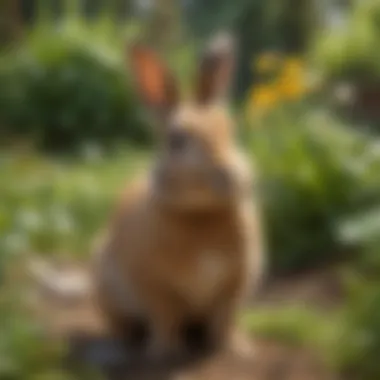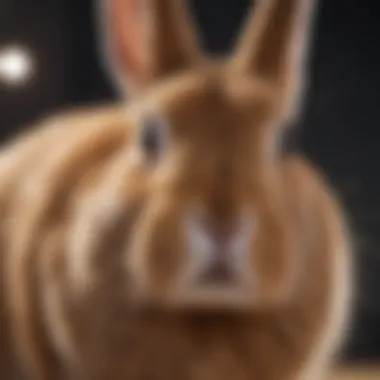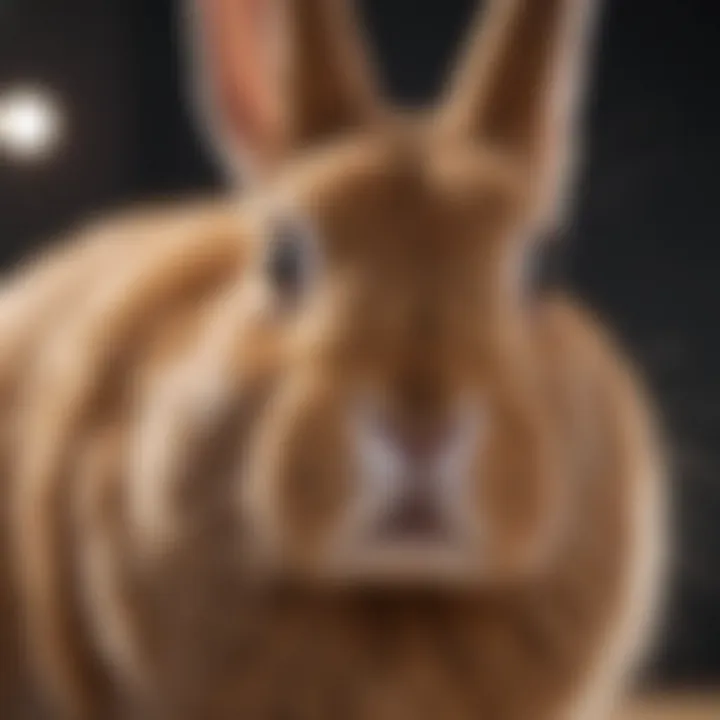Understanding Rabbit Behavior: Insights for Pet Owners


Intro
Understanding rabbit behavior is not just about knowing how to care for these delicate creatures; it's about unlocking a window into their world. Rabbits, being prey animals, often exhibit behaviors that might seem confusing or even elusive to the untrained eye. However, by paying attention to their actions and correlating them with their instincts and domestic environments, pet owners can enhance their relationships with these gentle beings.
The aim here is to shed light on what rabbits do and why they do it. You’ll discover how various instincts shape their behavior, from their natural tendencies to their learned responses in a home setting. This understanding extends beyond just interpretation—it leads to better care, which ultimately promotes a thriving rabbit population in our homes. By the end, you’ll be better equipped to foster a deeper bond with your furry companions.
Understanding Your Pet
Pet Behavior Basics
Every rabbit has its own distinct personality, but certain behaviors can be observed across the species. Knowing the basics aids in recognizing what your pet may need or how it feels.
- Thumping: This refers to a rabbit thumping its hind foot on the ground. It’s a warning sign, similar to a bell going off, indicating that the rabbit feels threatened or senses danger.
- Binky: You might be surprised to see your rabbit jumping in the air, twisting its body mid-flight. This joyous leap signifies a happy and playful mood, originating from their wild instincts.
- Nesting: Female rabbits often show nesting behaviors—even if they are not pregnant. They may gather materials and make a cozy spot, which can signify a sense of security.
Common Breed Characteristics
Different rabbit breeds come with varying personalities and traits. For instance, Dwarf Hotots are known for their playful nature, while Flemish Giants are often quieter and more laid-back. Acknowledging these traits can help you better understand your specific pet, tailoring care to their unique needs.
Species-Specific Needs
Not all rabbits are created equal, even within the same breed. Understanding their instincts, social requirements, and need for space is paramount:
- Space and Freedom: Rabbits are naturally inclined to hop and roam. Configuring your living space to allow them to explore can reduce stress.
- Social Animals: Many rabbits thrive in pairs. Companionship is key to their happiness, and they often play off one another’s energy.
Pet Care and Maintenance
Feeding Guidelines
Rabbits require a diet rich in hay, fresh vegetables, and a limited quantity of pellets. Hay—like Timothy or Orchard grass—should make up the bulk of their diet. Providing a varied mix of greens, such as parsley, cilantro, or romaine lettuce, ensures optimal health and prevents boredom.
Grooming Essentials
Rabbit grooming often goes beyond the occasional brush. Regular examinations for mats, especially in long-haired breeds, are recommended. Nail trimming is another essential aspect, as overgrown nails can lead to health issues.
Hygiene Practices
Keeping your rabbit's living space clean is vital. Regularly cleaning their litter box and changing bedding should be a part of your routine to minimize odors and maintain their health.
Training and Development
Basic Commands and Skills
Rabbits can be litter trained and taught certain commands, although it requires patience. Using a consistent signal, like a word or a sound, can help them connect actions with outcomes.
Behavioral Training Techniques
Using positive reinforcement—like treats or favorite snacks—encourages your rabbit to repeat desired behaviors. Avoid negative reinforcement, as it can lead to stress, which is counterproductive to their training.
Addressing Common Behavior Issues
Often, behavioral issues can arise when a rabbit feels threatened, lonely, or bored. Creating a safe, enriching environment with toys and tunnels can help alleviate anxiety. Observe and adjust as needed to promote healthy habits.
Health and Wellness
Routine Vet Check-ups
Regular veterinary visits are crucial for monitoring your rabbit's health. Routine check-ups can catch potential problems before they escalate.
Vaccination Needs
Vaccinations play a significant role in keeping your rabbit healthy. It's important to discuss with your vet about the necessary shots based on your geographical region.
Recognizing Signs of Illness
Rabbits often hide their discomfort. Look for changes in eating habits, movement, grooming, or behavior. If your rabbit becomes less active or stops eating, it may indicate illness and warrants a visit to the vet.
Enrichment and Activities
Indoor vs. Outdoor Activities


While outdoor play can be enriching, it should always happen under supervision to protect against predators. Indoors, setting up an obstacle course can stimulate their minds and encourage exercise.
Interactive Toys and Games
Rabbits love to chew and explore. Providing them with chew toys, tunnels, or even cardboard boxes can hold their interest and keep them active. Another option is fruit or vegetable treats hidden within toys, which makes for an engaging scavenger hunt.
Socialization Opportunities
As social creatures, rabbits benefit from interactions with humans and other pets. Introducing them gradually to new friends or family members can help them become well-adjusted, happy animals.
Prelims to Rabbit Behaviors
Understanding rabbit behaviors provides a crucial foundation for pet owners, allowing for a deeper bond with these creatures. Rabbit behavior is a window into not just their needs but their emotions and personality traits as well. This section will delve into what makes learning about rabbit behavior not just important, but essential for ensuring the health and happiness of these pets.
Overview of Rabbit Behavior
Rabbits, while often perceived as simple companions, present a rich tapestry of behaviors that reflect their complex social structures and personalities. Each movement, from a gentle twitch of their whiskers to a playful hop, holds significance. For instance, a happy rabbit might exhibit a behavior known universally as "binkying," characterized by spontaneous jumps and twists that signal joy. Understanding these behaviors can help owners respond appropriately, fostering a safe and enriching environment.
A rabbit’s behavior is not solely instinctive; it is also shaped by the experiences they have with their environment and caretakers. A bunny that is handled gently from a young age may grow up more trusting and affectionate than one that has had negative interactions. By observing and interpreting these daily actions, owners can learn important insights that go beyond care routines, offering a glimpse into the rabbit’s mood, comfort level, and overall well-being.
Importance of Understanding Behaviors
Grasping the various behaviors of rabbits not only enhances pet care but also strengthens the bond between rabbit and owner. The ability to interpret actions correctly can lead to better communication, ensuring that their needs and desires are met in a timely manner. For example, a rabbit that thumps its hind legs is likely expressing intolerance or alerting to possible danger. Recognizing this as a signal rather than merely a random act can shift an owner’s approach to their pet's environment.
Moreover, understanding rabbit behaviors can prevent misinterpretation and potential stress on both ends. When pet owners are aware of moods indicated by body language, they can adapt their interactions, providing a more tailored experience for their rabbits. This not only enhances the rabbit's trust but also elevates the quality of the owner’s experience.
"An informed owner is a rabbit's best friend. Knowing what each twitch and hop means is the path to a harmonious relationship."
In essence, investing time to learn about rabbit behaviors is not just a hobby; it’s a commitment to a happy and healthy life for these cherished pets. Engaging with them on a behavioral level invites a deeper connection, revealing the rich inner world of these remarkable animals.
Common Rabbit Behaviors and Their Meanings
When it comes to understanding rabbits, getting a grasp on their behaviors is absolutely crucial. Each action they take can speak volumes not just about their state of mind but also about their well-being. In this section, we’ll explore how these common behaviors—nudging, binkying, thumping, and scooting—reveal a rabbit’s needs and emotions. By recognizing what these behaviors mean, rabbit owners can ensure a happier, healthier life for their pets.
Nudging and Nosing
One behavior that often catches the eye is nudging, or nosing. When a rabbit nudges you with its nose or pushes you gently, it’s usually a sign of affection or a request for attention. This affectionate gesture can also signal curiosity. For example, if your rabbit is exploring its environment, it may gently nudge objects or people around it, looking for potential food or just something interesting to investigate.
Rabbits are naturally social creatures, so responding to this behavior positively helps strengthen your bond. A little stroke behind the ears or providing a treat can affirm to your rabbit that it’s doing a good job engaging with you.
Binkying
If you've ever seen a rabbit suddenly leap into the air and twist its body, you’ve witnessed what’s called a binky. This joyous display depicts a rabbit's happiness and contentment. It’s like their version of a happy dance—something they do when they feel safe and cherished in their environment.
When they binky, it signifies that the rabbit is in a state of joy. If your rabbit is performing binkies while you’re present, it means they feel comfortable enough to express their delight in front of you. Understanding this behavior not only warms the heart but also highlights the importance of providing a secure and enriching home for your pet.
Thumping
On the flip side, thumping is a behavior that certainly raises eyebrows. When a rabbit thumps its hind legs on the ground, it usually indicates alarm or discomfort. This behavior is often a way of communicating with other rabbits or signaling danger. For example, if your pet senses a strange noise or sees an unfamiliar person, you might notice it thumping repeatedly.
This behavior demands attention. If your rabbit is thumping often, expect to investigate the source of its unease. It could be anything from an environmental change to a lurking predator—real or perceived. Careful observation and proactive measures can help alleviate your rabbit’s stress.
Scooting
Another interesting but often misunderstood behavior is scooting. When a rabbit slides its body across the floor, this could be mistaken for a form of playfulness, but it's commonly a sign of discomfort or an attempt to mark territory. Sometimes, it can indicate that a rabbit is feeling overly confident or playful, especially if done in a binky-like manner close to you.
However, scooting can also hint at physical issues, such as anal gland problems or irritation. Always keep an eye on this behavior; it’s best to consult a vet if scooting becomes frequent, as it can indicate health issues beneath the surface.
"Understanding your rabbit’s behavior is crucial for their overall well-being and happiness. Each action they display can serve as a window into their world."
By diving into these behaviors, owners can gain invaluable insights that allow them to tailor their care practices more effectively. Recognizing the nuances beneath these actions can significantly impact your rabbit’s overall health and happiness.
Social Dynamics Among Rabbits
Understanding the social dynamics among rabbits is pivotal for anyone keen on caring for these lively creatures. Rabbits are not solitary animals; they thrive in groups, forming intricate relationships with their companions. Recognizing these social structures can enhance the well-being of pet rabbits significantly, making it essential for owners to grasp the nuances of their interactions.
Establishing Hierarchies
Hierarchy among rabbits is a fascinating aspect of their social behavior. In a group, rabbits often establish a pecking order, which is critical for reducing conflicts and competition. This order doesn’t simply dictate who eats first; it also shapes how rabbits interact with one another throughout their lives. Dominance is not always about aggression; sometimes, it's as subtle as a change in posture or the way one rabbit approaches another.
Living in harmony is crucial for their health and emotional stability. When a new rabbit is integrated into a group, you might witness a process akin to a delicate dance, where adjustments are made until a new hierarchy is established. Patience during this phase is essential. It’s not uncommon for owners to observe behaviors like circling or nudging, signaling the establishment of boundaries. Understanding these signals helps in maintaining a peaceful coexistence in multi-rabbit households.


Grooming and Affection
Grooming serves as more than a hygienic practice; it is also a vital expression of affection and social bonding among rabbits. When one rabbit grooms another, it is much like a warm embrace in a human relationship. This act fosters trust and strengthens connections, playing a crucial role in their social dynamics. Pet owners can encourage such behavior by providing positive reinforcement when rabbits groom each other or even when they groom their humans.
Rabbits are meticulous creatures, and watching them groom can be remarkably soothing. It’s a window into their emotional states. If your rabbit initiates grooming, it’s a strong sign that they feel comfortable and secure in their environment. On the flip side, if grooming is skipped, it could indicate tension or discomfort in their relationships. Keeping a keen eye on these dynamics allows owners to intervene early, ensuring a nurturing environment for their rabbits.
Playful Interactions
Play is not just for fun; it's a crucial component of a rabbit's social life. Engaging in playful interactions can reveal much about their personality and behavior. Binkies, those delightful leaps and twirls in the air, often highlight a rabbit's joy and contentment. When they chase or engage in a gentle tussle with each other, it's a way of establishing their social bonds. Playful behavior is an essential outlet for energy that can prevent boredom, which in turn reduces problematic behaviors.
Moreover, facilitating playtime can significantly enhance your rabbit's quality of life. This can be done through creating safe spaces filled with tunnels, toys, and other stimulating environments. Regular play does wonders not just for their physical health but also for their mental well-being.
"A happy rabbit is a healthy rabbit; understanding their social interactions often unlocks the key to contentment."
Ultimately, acknowledging these social dynamics among rabbits is not just about observation; it's about fostering an environment where they can thrive. With the right knowledge, owners can provide a nurturing atmosphere that respects their natural behaviors, leading to happier and healthier rabbits.
Instinctual vs. Learned Behaviors
Understanding the distinction between instinctual and learned behaviors is crucial when caring for rabbits. This knowledge not only aids in interpreting a rabbit's actions but also helps pet owners provide environments that cater to each behavior type. Instinctual behaviors are those rooted in genetics, often geared towards survival. In contrast, learned behaviors develop over time through interactions within their environment or with humans. Knowing how these two elements interplay can greatly enhance a rabbit's quality of life, deepen the bond between owner and pet, and lead to better overall care.
Instinctual Behaviors in the Wild
Rabbits are prey animals, and many of their instinctual behaviors stem from the need to survive in the wild. These behaviors are often ingrained, passed down through generations. A few notable instinctual behaviors include:
- Hiding: Wild rabbits dig burrows or find dense cover to escape predators. This instinct remains in domesticated rabbits. If a rabbit feels threatened, it might seek a secluded spot to feel safe.
- Grooming: Grooming is both an instinct and a social behavior. In the wild, rabbits will groom themselves and each other to remove dirt and parasites, while also helping to strengthen social bonds. This behavior is frequently observed in domestic rabbits as well.
- Digging: In their natural habitat, rabbits dig to create tunnels or burrows. This behavior can also surface in domesticated rabbits, where they might dig in their litter box or on your carpet. It fulfills their instinctual need to burrow and explore.
These behaviors, when recognized and understood, can lead to an enhanced environment for pet rabbits, allowing for active engagement and reducing stress.
Adaptations to Domestication
As rabbits transitioned from the wild to domestic life, they adapted their behaviors to fit a new environment. This has led to unique behavioral changes that reflect their experiences with humans. Some adaptations include:
- Socialization: Domesticated rabbits often develop more complex social behaviors. They may form bonds with their humans, responding to voices and seeking attention, which contrasts with their more solitary behavior in the wild.
- Learning Commands: Unlike their wild counterparts, domesticated rabbits can learn tricks or commands. Many pet owners have successfully taught their rabbits to respond to their names or to follow simple commands like "come here" or "no."
- Changing Feeding Behaviors: In the wild, rabbits graze on various plants, always alert for danger. In contrast, domesticated rabbits typically eat the same foods regularly. Owners can provide vegetables and hay but should consider their rabbits' preferences and previous dietary habits.
These learned behaviors can significantly enrich a rabbit's life, leading to more interactions, fun activities, and ultimately a happier pet.
"Understanding both instinctual and learned behaviors in rabbits allows for better care and a stronger bond with these intelligent creatures."
Recognizing the interplay between instinct and learning makes a meaningful difference in how rabbit owners approach their pet care. This awareness fosters an environment that encourages both types of behaviors, promoting emotional stability and well-being for pet rabbits.
Behavioral Changes and Their Significance
Understanding behavioral changes in rabbits is key to ensuring their health and happiness. These subtle shifts often act as a window into their emotional and physical well-being. Pet owners must recognize that when rabbits behave differently from their usual patterns, it could indicate something amiss in their environment or health. By identifying these changes, one can intervene timely, thereby enhancing the overall care and bond shared with their furry companions.
Rabbits, though seemingly delicate creatures, possess a complex array of behaviors driven by instinct or learned experiences. Observing how these behaviors fluctuate can offer insights about their comfort levels, stressors, or health problems. It's crucial to pay attention as it forms the foundation for preventive care. Being proactive rather than reactive not only mitigates suffering but also nurtures trust in the rabbit-human relationship.
Signs of Stress or Discomfort
Rabbits are notoriously good at hiding their stress or discomfort until symptoms become glaringly obvious. However, a pet owner with a keen eye can often notice these signs before they escalate. Common indicators include:
- Changes in Eating Habits: A decreased appetite can signal distress. If your rabbit ordinarily demolishes their food but suddenly shows little interest, it merits attention.
- Hiding or Withdrawal: If a rabbit that usually hops around becomes a couch potato, it may be seeking solace from distressing factors or recognizing a health issue.
- Rapid Breathing: Elevated heart rate or breathing can indicate anxiety or pain.
- Aggressive Behavior or Thumping: Sudden thumping or biting, unusual for your rabbit, is often a call to arms about their discomfort.
By paying attention to these signs, owners can make necessary adjustments to their pet's environment or seek veterinary advice as needed. It's not just about recognizing discomfort but truly understanding the triggers that lead to such behaviors.
Recognizing Health Issues Through Behavior
Behavior is often an early warning system for health problems. A rabbit’s natural inclinations can sometimes flip the script when they experience pain or illness. Here are behaviors that can signal health issues:
- Less Grooming: Rabbits prioritize grooming, so a marked reduction may highlight pain.
- Altered Mobility: If the rabbit becomes less active or shows hesitation in jumping, it could indicate joint pain or other issues.
- Unusual Vocalizations: Unlike dogs and cats, rabbits often remain quiet, so any atypical sounds can indicate distress or discomfort.
- Increased Aggression: A normally easy-going rabbit acting out can be a signal that they are in pain or uncomfortable.
"A rabbit might not always show you when they are sick, but behavioral changes tell a story worth listening to."
By monitoring these behaviors, pet owners can ensure that interventions are made swiftly. Keeping a journal documenting unusual behaviors can also assist in recollecting patterns, which can be invaluable during veterinary visits.
Creating a Stimulating Environment
Creating an enriching environment for rabbits goes beyond providing basic shelter and food; it’s crucial to their emotional health and overall well-being. Rabbits of any breed are naturally curious creatures, and they thrive in settings that stimulate their minds and allow them to express their instinctual behaviors. Failing to offer such an environment can lead to boredom, anxiety, and even aggression. So, pet owners need to think creatively about how to provide a dynamic habitat for their furry companions.
A well-designed environment caters to both physiological needs by providing adequate space and stimulation, and it plays a significant role in fostering an emotional bond between the rabbit and its owner. Enrichment activities can include safe toys, obstacle courses, and social interactions that facilitate natural behaviors—each of these elements is essential for nurturing a well-adjusted rabbit.


Importance of Enrichment
Enrichment is often the name of the game when it comes to enhancing a rabbit's quality of life. Here’s why:
- Mental Stimulation: Rabbits require mental exercise, just like physical activity. Toys, puzzles, and more complex habitats encourage them to explore, think, and learn.
- Behavioral Health: A lack of stimulation can lead to stereotypic behaviors, which are repetitive and often harmful actions. Enrichment keeps rabbits engaged and reduces stress, promoting healthier habits.
- Physical Activity: An enriched environment encourages binkying—those joyful leaps in the air—and running around. This type of exercise is vital for their cardiovascular health.
- Natural Instincts: Simulating the wild allows the rabbit to dig, hide, and forage, actions that are critical for their instinctual behaviors. This connection to their instincts can significantly improve their emotional well-being.
To sum up, a stimulating environment allows rabbits to flourish both physically and emotionally, making it a vital aspect of responsible pet ownership.
Toys and Interactive Activities
When it comes to keeping rabbits entertained, the right toys and activities are as important as fresh carrots on a Sunday brunch. It's not just about aesthetics; these toys can positively influence behavior and enhance the bond between rabbit and owner.
Here are some types of toys and interactive activities that can enrich your rabbit’s life:
- Chew Toys: Wooden blocks, willow balls, or untreated cardboard serve dual purposes: they satisfy the rabbit's chewing instinct and keep their teeth healthy.
- Hideaways and Tunnels: Providing places to hide or burrow can make a rabbit feel safe and secure. These structures mimic their natural environment quite well.
- Puzzle Feeders: These not only provide food but also challenge the rabbit's problem-solving skills. Foraging behavior can be simulated with a feeder that requires the rabbit to figure out how to retrieve the treats hidden inside.
- Interactive Playtime: Engaging with your rabbit through gentle games can strengthen your bond. Simple activities like hide and seek or gentle tug-of-war with a soft toy can be rewarding for both parties.
Remember, the goal is to create a balanced environment where the rabbit has enough stimulation to keep its mind sharp but not so much that it becomes overwhelmed. Rotating toys and introducing new activities periodically can keep things fresh and exciting.
"Every rabbit is unique, finding what sparks joy for your pet may take time and experimentation."
By focusing on creating stimulating environments and engaging with your rabbit through various activities, pet owners can ensure their companions lead fulfilling, enriched lives.
Integrating Rabbit Behavior Knowledge into Care
Understanding rabbit behavior is more than just a pastime for pet owners; it is a cornerstone of responsible rabbit care. Grasping the subtle nuances of what your rabbit’s various actions signify allows you to cater to their needs better, nurture their well-being, and strengthen the bond you share. When you know that a gentle nudge means your furry friend is seeking attention, you can immediately respond to this need, fostering a deeper connection.
The benefits of integrating behavioral knowledge into everyday care are manifold. For one, observing their behavior can alert you to potential stressors in the environment. This might include changes like new pets, loud noises, or even variations in routine. By addressing these factors proactively, you provide a more stable and secure home.
Also, knowing your rabbit’s natural instincts can lead to a happier, healthier life for them. For instance, rabbits are natural diggers. By providing them with appropriate outlets—like a digging box filled with safe materials—you not only satisfy their instincts but also keep them from turning your living room into an excavation site.
Some considerations include:
- Creating a safe space: Make sure your rabbit has a designated area where they feel secure, especially during stressful times. This will ensure that they can observe their surroundings without feeling threatened.
- Monitoring interactions: If you have multiple pets, make sure they get along. Watch their social dynamics closely, as misunderstandings among pets can lead to stress for rabbits.
- Encouraging natural behaviors: Think about ways to replicate their natural habitat, perhaps with tunnels and hiding spots that challenge and engage them physically and mentally.
"Understanding rabbit behavior is not just about decoding their actions; it’s an essential aspect of ensuring their overall well-being and happiness."
When you respect your rabbit’s nature and instinct, you ultimately help in crafting an environment that is responsive to their needs, laying the groundwork for a more fulfilling companionship.
Enhancing Bond with Your Rabbit
Fostering a strong bond with your rabbit hinges on understanding and empathy for their behavior. It is essential to engage with your rabbit in ways that resonate with their instincts. For instance, when they exhibit curiosity by exploring their surroundings, join them by gently interacting within their space. This shared experience can significantly enhance the trust between you.
Some practical tips include:
- Respect their space: Every rabbit has their comfort zone. By allowing your rabbit to decide when to approach you, you cultivate trust.
- Use positive reinforcement: Treats can be a game changer. When your rabbit performs desired behaviors, rewarding them with their favorite snack fosters a strong bond.
- Daily interaction: Making time each day to engage with your rabbit, whether it’s through play or simple petting, builds a routine that they come to associate with positive experiences.
Effective Communication Techniques
Just like in human relationships, communication with rabbits is key. However, it requires a keen observation of their body language and vocalizations. Learning to read these signals can bridge the gap between what you perceive and what your rabbit actually needs.
A few key communication techniques include:
- Recognize body language: Ears up could mean curiosity or alertness, while ears back often signal discomfort. A relaxed posture equates to a content bunny.
- Vocalizations: Rabbits communicate through varying sounds. A soft grunt may indicate pleasure, while a thump can be a warning sign.
- Mirroring behavior: Sometimes, mimicking your rabbit’s behavior can foster a feeling of safety. If you notice your rabbit binkying, it’s their way of inviting fun—jumping in after can amplify that sentiment.
Integrating these techniques into your interactions builds a clearer line of communication, making it easier to understand your rabbit's wants and needs while reinforcing your bond.
The End: The Value of Behavioral Understanding
Understanding the actions and reactions of rabbits can be more than just a passing interest; it holds significant value for pet owners. By exploring their behaviors, we gain insights that can enhance the well-being of these gentle creatures and foster a more harmonious relationship. Robots, unlike some other pets, express their feelings through nuanced behaviors. Learning to read these signals is crucial for their happiness and health.
The Broader Impact on Pet Ownership
Behavioral understanding extends beyond mere observation. When pet owners comprehend what their rabbits are communicating through body language, thumping, or playful antics, they can respond in a way that nurtures trust and comfort. This awareness not only leads to happier rabbits but also contributes to a fulfilling pet ownership experience.
The positive effects of nail-biting enthusiasm about rabbit behavior can trickle down into numerous aspects of care:
- Stress Reduction: Recognizing signs of discomfort early allows for timely interventions, potentially avoiding health issues.
- Improved Health: Knowledge of what constitutes normal behavior aids in identifying when something is off. This proactive approach can lead to quicker diagnostic resolutions and better overall health outcomes.
- Stronger Bonds: A rabbit that feels understood is likely to become more affectionate. Engaging with them in a way that respects their comfort cues enhances the emotional connection between pet and owner.
"An informed pet owner is an empowered pet owner."
Ongoing Learning and Adaptation
Just as rabbits adapt their behaviors based on their environments, so too must their human companions. The world of rabbit behavior is vast and continually evolving, largely influenced by factors such as diet, living conditions, and social interactions. Pet owners should embrace a mindset of ongoing learning, remaining open to adjusting their care practices as new insights emerge.
- Stay Updated: Engaging with communities, such as forums on Reddit or following reputable sources on Facebook, can provide valuable perspectives and support from fellow rabbit enthusiasts.
- Experimentation: Don’t hesitate to try new forms of enrichment or different approaches to handling stress in rabbits. Observing the effects can yield insights that enhance understanding over time.
- Education Resources: Delve into literature on rabbit behavior and training, which may uncover techniques or practices previously unconsidered.
By maintaining a curious spirit and being willing to adapt strategies in caring for their rabbits, owners can ensure their pets thrive in a loving environment. In essence, understanding rabbit behavior isn't a one-time study, but an ongoing journey that enriches both pet and owner.







